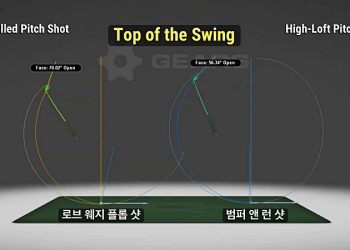필자가 PGA 프로가 된 후 PGA 마스터 프로페셔널(Master Professional)이 될 때까지 28년이 걸렸다. 골프를 잘 칠 수 있게 가르치는 일을 직업으로 삼고 관련된 많은 일을 했다. 오랜 세월 동안 나의 골프 철학은 늘 한결같다.
첫째, 교과서적인 기본은 절대 실패하지 않는다. 둘째, 스윙의 올바른 순서는 빠르게 치는 것보다 중요하다. 셋째, 늘 안정된 피니시 동작이 가장 중요하다.
드라이버를 똑바로 멀리 치는 것은 골프들의 한결같은 희망이다. 그러기 위해서 반드시 지켜야 할 것이 바로 필자가 터득한 위의 세 가지 기본 사항이다.
먼저 어드레스 자세는 전체 스윙에 영향을 준다. 스윙의 정면 모습은 볼의 탄도, 비거리와 관련이 있다. 어드레스 자세의 측면 모습은 볼의 방향에 직접 관련된다. 스윙이 시작되고 끝날 때까지 걸리는 시간은 1.5초 전후로 짧다.
어드레스 자세에서 스윙이 출발할 때, 스윙은 클럽을 잡고 있는 손이나 팔이 아니라 왼쪽 어깨 회전에 의해 백스윙이 진행되어야 한다. 이때 몸의 다른 부분은 움직임 없이 왼쪽 어깨의 진행에 따르게 된다. 어드레스에서 스윙의 탑까지 걸리는 시간은 대략 0.9초 전후다.
백스윙이 진행될 때 순간적으로 숙여진 상체의 각도가 앞 또는 뒤로 움직일 수 있다. 본인이 이를 인지하기는 쉽지 않다. 하지만 어드레스 자세에서 양 발바닥의 느낌을 섬세하게 느끼는 것이 중요하다. 어드레스 때 체중은 측면에서 볼 때 발바닥 중심과 앞쪽 사이에 위치한다. 지면에서 느끼는 이런 체중의 분포는 스윙이 진행되면서 매 순간 변하게 된다.
어드레스 때 거의 동일하게 앞쪽에 분포되었던 체중은 스윙의 탑 동작에서는 대부분 오른발 뒤꿈치 쪽으로 이동된다. 왼발의 체중 분포는 발가락 쪽으로 옮겨진다.
백스윙 동작의 끝은 왼쪽 어깨의 최대 회전에 의해 마무리된다. 어깨가 주도적으로 스윙을 이끌고 몸을 완전한 코일 상태로 만들어 하체로 에너지를 저장한다. 이러한 느낌은 오른쪽 발바닥 뒤꿈치에서 느낄 수 있다.
어드레스에서 백스윙 탑은 다운스윙을 하기 위한 기본이기도 하다. 올바른 스윙의 순서를 지킨다는 것은 다운스윙의 시작에서 나온다. 즉, 완성도가 높은 백스윙 자세 없이는 순서 있게 진행되는 다운스윙은 어렵다고 할 수 있다.
다운스윙은 왼쪽 골반이 주인이 된다. 왼쪽 골반이 체중을 45도 사선으로 이동시키며 회전하면서 시작된다. 백스윙의 완성도가 부족하면 이러한 다운스윙의 트랜지션은 왼쪽 골반보다는 상체가 덤비듯이 목표 쪽으로 이동하며 스윙을 망치게 된다. 스윙도 급해지고 팔에 의존해 급하고 빠른 스윙 동작이 본인의 의지와는 상관없이 나타난다.
임팩트 자세에서 머리 위치는 정면에서 볼 때 어드레스 위치보다 살짝 오른쪽에 놓이게 된다. 이는 왼쪽 골반의 회전과 이동에 의해 만들어진 결과물이다. 임팩트 순간 볼 방향은 양어깨의방향선에 의존된다. 어깨가 10도 미만으로만 열려야 원하는 구질을 만들 수 있다. 반면 배꼽 부분, 즉 골반 전체의 정면 방향이 45도 회전된 상태에서 임팩트 되어야 한다.
발바닥에서 느끼는 체중의 분포는 임팩트 순간에 강하게 느낄 수 있다. 왼발 전체에 체중이 실리면 샷의 방향은 안정적으로 가져갈 수 있다. 몸의 체중도 대부분 왼발에 실리게 된다. 이러한 임팩트 순간을 지나면서 안정된 릴리스도 나타난다.
볼과 클럽의 접촉 시간을 길게 만들수록 볼은 멀리 날아간다. 릴리스 동작이 볼의 방향과 거리에 영향을 주는 이유도 여기에 있다. 어드레스 때 숙여진 상체의 각이 임팩트와 릴리스 동작에서 이어지면 볼의 방향성은 좋아진다.
탑에서 올바른 순서로 트랜지션이 만들어지면 임팩트와 릴리스도 함께 좋아진다. 완성된 피니시 자세에서 흔들림 없이 3초 전후로 스윙 자세를 유지한다면, 스윙은 처음부터 순서 있게 만들어졌다고 할 수 있다.
매 순간 움직임에 의해 진행되는 골프 스윙은 어느 정적인 특정 위치에서 설명될 수 없다. 어느 한 부분의 자세가 잘못되었다면 원인은 그보다 훨씬 이전 단계에서 발생했다고 볼 수 있다.
결론적으로 모든 스윙은 안정된 어드레스 자세에서 출발한다고 볼 수 있다. 그래야 올바른 움직임이 시작되는 트랜지션도 만들 수 있다. 올바른 순서로 진행된 스윙은 임팩트 순간에 모든 볼의 방향과 거리를 만들어낸다. 그리고 흔들림 없이 멋진 피니시 자세에서 볼의 날아가는 궤도도 확인할 수 있다.
☞ 전욱휴는…
서울대 졸업 후 미국에 유학, 1996년 PGA 클래스A 프로가 됐다. 이후 28년만인 2024년 전 세계 골프계 최고 권위의 ‘PGA 마스터 프로페셔널’ 자격을 획득했다. SBS, MBC, JTBC, YTN 등의 골프 채널 진행자 및 해설자로 활약했고, 지금은 애틀랜타와 한국을 오가며 골프 레슨 및 골프 관련 비즈니스를 하고 있다. chungolf@gmail.com
[Dr.Eric Chun’s Golf Lesson] 34. To hit the driver straight and long!
Proper swing fundamentals, seamless swing continuity, and a stable finish position
Becoming a PGA professional and achieving the status of PGA Master Professional took 28 years. Throughout that time, I made teaching the art of golf my career, involving myself in many related endeavors. My golf philosophy has remained steadfast over the years:
1.The Fundamentals never fail.
2. Sequencing is way more important than Speed.
3. Stability is King.
The address posture influences the entire swing. The frontal view of the swing relates to ball trajectory and distance, while the side view of the address posture directly affects ball direction. A full swing lasts approximately 1.5 seconds, a brief moment that is visually fast. When analyzing a full swing, up to 71 distinct areas can be observed, often examined through slow-motion video for detailed analysis.
At the start of a swing, the movement initiates with the rotation of the left shoulder, not with the hands or arms. The backswing is driven by this rotation, with the rest of the body following naturally. From the address to the top of the swing, this phase takes about 0.9 seconds.
During the backswing, the body’s inclination can subtly shift forward or backward without the golfer’s awareness. Yet, it is essential to maintain an acute awareness of the feeling in both feet at the address. The body weight, when viewed from the side, is distributed between the center and the front of the feet. This weight distribution changes throughout the swing.
At the top of the swing, the weight distribution shifts significantly between the left and right feet. What started as a balanced weight distribution at the address transfers primarily to the right heel, while the left foot’s weight moves towards the toes. Simply being aware of this shift helps minimize unnecessary forward or backward movement. The top of the backswing ends with the maximum rotation of the left shoulder, leading the body into a fully coiled state and storing energy in the lower body, which can be felt in the right heel.
The transition from address to the top of the backswing sets the foundation for the downswing. A proper downswing sequence begins with the movement of the left hip, which rotates and shifts weight diagonally at a 45-degree angle. This transition is only possible with a stable and complete backswing. If the backswing lacks completion, the downswing will be led by the upper body lunging forward, disrupting the entire sequence and leading to rushed, arm-dependent swings.
Impact is a critical moment that reflects the quality of the top position. At impact, several key areas must be observed. The head position, when viewed from the front, should be slightly right of where it was at address, a result of the rotation and shift of the left hip. The direction of the ball at impact depends on the alignment of the shoulders, which should be open by no more than 10 degrees to achieve the desired shot shape.
Meanwhile, the torso should be rotated about 45 degrees to face the target at impact, ensuring the upper body remains inclined and allows solid contact. The weight distribution at impact should be strongly felt through the entire left foot, providing control over the shot’s direction, with most body weight centered over the left side.
Following impact, a stable release ensures the club remains in contact with the ball for a longer duration, maximizing distance. The release directly influences both direction and distance, and maintaining the upper body’s original angle through impact and release improves directional control.
A correct transition sequence from the top improves impact and release, leading to a stable, unhurried finish. Holding a balanced finish for about 3 seconds signals that the swing was executed in the proper sequence from start to finish.
A golf swing cannot be explained by static positions alone; it is a dynamic motion. Any perceived flaw often has roots in an earlier phase of the movement.
In conclusion, an unwaveringly stable address is essential. The swing begins with this foundation, allowing for a seamless transition. A properly sequenced swing results in accurate impact and distance, with a steady finish that enables the golfer to observe the ball’s flight path with confidence.




![[전욱휴의 골프레슨] 34. 드라이버 똑바로 멀리치기](https://www.atlantajoongang.com/wp-content/uploads/2024/11/collage-750x469.jpg)













![[전욱휴의 골프 레슨] 46. 배치기(얼리 익스텐션)](https://www.atlantajoongang.com/wp-content/uploads/2025/03/photoKakaoTalk_20250306_073237889_01-350x250.jpg?v=1741361116)
![[전욱휴의 골프 레슨] 45. 임성재 '행온페이드' 샷](https://www.atlantajoongang.com/wp-content/uploads/2025/02/collage1-350x250.jpg)
![[전욱휴의 골프레슨] 44. 일관된 샷을 원한다면](https://www.atlantajoongang.com/wp-content/uploads/2025/02/QKakaoTalk_20250212_065748485-350x250.jpg)

![[전욱휴 골프 레슨] 42. 오른쪽 팔꿈치 역할](https://www.atlantajoongang.com/wp-content/uploads/2025/01/qQ1KakaoTalk_20250130_072058648-350x250.jpg)
![[전욱휴의 골프 레슨] 41. 매킬로이 파워 스윙](https://www.atlantajoongang.com/wp-content/uploads/2025/01/qQ1KakaoTalk_20250122_123635940-350x250.jpg)





![춘추여행사 항공 티켓 담당자들이 고객 상담을 하고 있다. [업체 제공]](https://www.atlantajoongang.com/wp-content/uploads/2025/07/66a6b235-cd88-45e6-a54c-6a0d02f5ece2-350x250.jpg)
